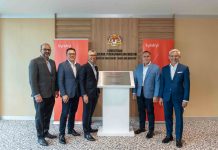
With recent incidents involving heavy rainfall and typhoons in several locations around Asia, the region should be prepared to address both climate change and rising energy demand to meet their economic ambitions.
In regard to this, Mitsubishi Power executive vice-president Takao Tsukui emphasised that proper energy infrastructure will be key in addressing the challenges of climate change and that the rollout of new, cleaner energy must do more than replace the existing infrastructure.
“It must also keep pace with the growing energy demand, which continues to rise alongside Asia’s economies. New technologies like data centres and artificial intelligence (AI) are especially energy intensive,” Tsukui noted, adding that Malaysia in particular has greatly benefitted from traditional energy sources.
Despite this, Tsukui pointed out that Malaysia, like many other countries, recognises the urgency of climate change and has been committed to achieving net-zero emissions by 2050, with 70% of its energy coming from renewable sources.
However, he said a common challenge faced by many Asian countries is balancing the energy transition with the rising demand driven by strong economic growth.
“No single country or company can achieve (its) energy goals alone. But it is within reach, which is why we must collaborate across sectors, regions and borders,” he added.
Expanding Gas Turbine Expertise in APAC
Meanwhile, Mitsubishi Power Asia Pacific Pte Ltd announced the expansion of its gas turbine expertise in Southeast Asia, given the significant utilisation potential of natural gas and liquefied natural gas (LNG) in the region.
On this, its managing director and chief executive officer Akihiro Ondo said the company’s gas turbine has the capability to co-fire with hydrogen up to 30%.

“We see significant potential in Southeast Asia for the utilisation of natural gas or LNG. This is the real transitional solution for the region. Plant owners can begin operations using 100% natural gas.
“Once the hydrogen supply chain becomes economically viable, plants can start co-firing with hydrogen up to 30%. We can then gradually increase this co-firing ratio to 50% and eventually 100%, depending on the supply chain’s development,” he said.
Ondo, who has helmed the company since April 2023, sees a lot of growth in the Asia Pacific region, particularly Southeast Asian markets, namely Malaysia, Indonesia, Singapore, Vietnam and the Philippines.
“Malaysia will have the continuous addition of power generation,” he said, referring to the latest contract secured by the company earlier in August.
Mitsubishi Power secured a contract to supply advanced gas and steam turbines for a new 500-megawatt (MW) gas turbine combined cycle (GTCC) power plant in Miri, Sarawak, which is owned by PETROS Power, a subsidiary of Petroleum Sarawak Bhd.
The project is part of Sarawak’s broader strategy to enhance energy security and support economic growth under the Sarawak Gas Roadmap and is on track to be operational by 2027.
“We started basic engineering (in the project). Then we have a lot of technical sessions with our engineering, procurement, construction and commissioning (EPCC) contractor from China and also Petros,” he added.
According to Ondo, the new GTCC opportunity in Miri will open doors to enhance Mitsubishi Power’s commitment to power stations in Malaysia.
The company has also completed construction of the 8th and final M701JAC unit of a 5,300MW natural gas-fired power plant project in Thailand, which is a joint venture between Gulf Energy Development Public Company Limited and Mitsui & Co Ltd.
The project commenced full operations on 1 October 2024.
Ondo also said that the company would continue to provide support in decarbonisation efforts in Asia Pacific as the company’s core expertise is to provide technological solutions and power generation systems, as evident with its 550MW power station in the company’s factory in the western part of Japan.
“We started to install the hydrogen production facility and produce hydrogen storage in one place. This kind of investment in technological validation is the most important part for us to contribute to decarbonisation.
“We will continue our approach and provide a commercialised solution to the region and around the world,” he noted.














